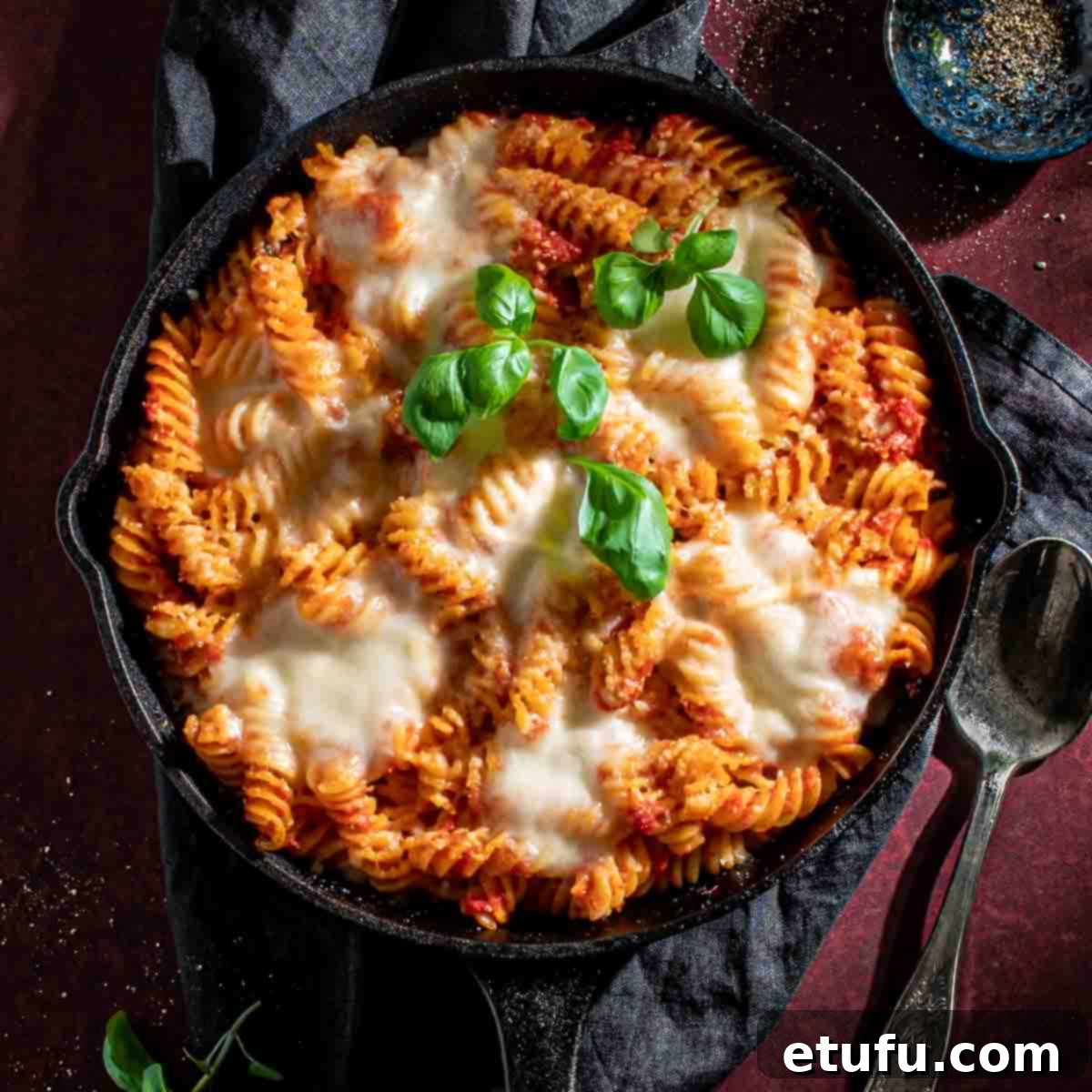Experience Italy: The Authentic Pasta alla Sorrentina Recipe
Embark on a culinary journey to the sun-drenched Amalfi Coast with our exquisite Pasta alla Sorrentina recipe. This iconic Italian pasta dish, hailing from the picturesque town of Sorrento in Southern Italy, is a vibrant celebration of Mediterranean flavors and the heart of Neapolitan cuisine. Simple yet profoundly delicious, it masterfully combines fresh, high-quality ingredients to create a dish that is both comforting and deeply satisfying.
At its core, Pasta alla Sorrentina features perfectly cooked pasta, a rich and fragrant tomato sauce, aromatic garlic, fresh basil leaves, sharp Parmigiano Reggiano, and luscious chunks of mozzarella cheese. What truly sets this recipe apart is its signature preparation: the pasta is lovingly layered twice with generous amounts of both cheeses, then briefly baked to golden perfection until the mozzarella melts into a gloriously gooey, irresistible blanket. The result is a symphony of textures and tastes that captures the very essence of Italian home cooking.
More than just a meal, Pasta alla Sorrentina embodies Italy’s rich cultural heritage and its unwavering dedication to culinary traditions. It’s a testament to how humble, high-quality ingredients, handled with care and passion, can transform into an extraordinary dish. Preparing this classic in your own kitchen offers more than just a treat for your taste buds; it’s an opportunity to connect with the soulful spirit of Italy and immerse yourself in the warmth of its Mediterranean culinary art. Get ready to indulge in a truly authentic Italian experience. Buon appetito!

Italy – A Glimpse into the Heart of European Culture

Italy, a nation celebrated for its profound artistic heritage, stunning landscapes, and, of course, its unparalleled culinary contributions, holds a special place in the global imagination. From ancient Roman ruins to Renaissance masterpieces, and from the majestic Alps to the sun-kissed Mediterranean coast, Italy offers an endless array of wonders. Its cuisine, in particular, is a cornerstone of its identity, varying greatly from region to region but always rooted in fresh, seasonal ingredients and time-honhonored traditions.
| Location | Italy is strategically situated in Southern Europe, forming a distinctive boot-shaped peninsula that extends into the Mediterranean Sea. It shares land borders with France, Switzerland, Austria, and Slovenia, and its extensive coastline is famous for its breathtaking beauty and vibrant port cities. |
| Language | Italian is the official and most widely spoken language across the country, a beautiful Romance language known for its melodic qualities. However, Italy is also a rich tapestry of diverse cultures, with numerous regional dialects and minority languages spoken, reflecting centuries of distinct local histories and influences. |
| Population | Home to approximately 60 million people, Italy boasts a vibrant population that cherishes family, food, and community. Its cities blend ancient charm with modern life, while rural areas maintain traditional customs and a slower pace of living. |
| Trivia | Italy proudly hosts the world’s smallest sovereign state: the Vatican City. Nestled entirely within Rome, this tiny enclave, covering just 44 hectares, serves as the spiritual and administrative heart of the Roman Catholic Church. Despite its minuscule size, it houses some of humanity’s most revered cultural and historical landmarks, including the awe-inspiring St. Peter’s Basilica, Michelangelo’s masterpiece, the Sistine Chapel, and the Vatican Museums, which curate an immense collection of art and artifacts spanning millennia. It stands as a powerful symbol of faith, art, and history. |
Why You’ll Adore This Pasta alla Sorrentina Recipe
This Pasta alla Sorrentina recipe isn’t just another dish; it’s a culinary experience designed for maximum enjoyment with minimal fuss. Here’s why it’s destined to become a staple in your kitchen:
- Quick and Easy Preparation: Forget complicated steps and lengthy cooking times. This recipe is designed for simplicity, making it perfect for both novice cooks and seasoned chefs alike. You’ll be amazed at how quickly you can bring such authentic Italian flavors to your table.
- The Ideal Weeknight Dinner: After a long day, the last thing you want is a demanding recipe. Pasta alla Sorrentina fits seamlessly into your busy schedule, offering a wholesome and delicious meal that comes together effortlessly, transforming an ordinary weeknight into a special occasion.
- Ultimate Comfort Food: There’s something inherently soul-soothing about a warm, cheesy pasta dish, and this recipe delivers comfort in every bite. The rich tomato sauce, tender pasta, and melted mozzarella create a harmonious blend that feels like a warm hug, perfect for any time you need a little indulgence.
- Fuss-Free Tomato Sauce with Passata: Unlike recipes that require hours of simmering whole tomatoes, our Pasta alla Sorrentina utilizes high-quality passata (also known as tomato puree). This simplifies the sauce-making process significantly, allowing you to achieve a deeply flavorful, smooth tomato sauce without any extra effort.
- A Crowd-Pleaser and Kid-Friendly Favorite: This classic Italian dish has universal appeal. Its comforting flavors and familiar ingredients make it a hit with both adults and children, guaranteeing clean plates and happy faces around the dinner table. It’s the perfect meal for family gatherings or entertaining friends.
- Excellent for Batch Cooking and Meal Prep: Planning ahead has never been easier! This recipe yields fantastic leftovers that can be stored in the refrigerator or freezer, making it an ideal choice for meal prepping. Enjoy delicious, homemade Italian food throughout the week with minimal reheating.
- Incredibly Versatile with Your Favorite Pasta or Gnocchi: While traditionally made with specific shapes, this recipe embraces flexibility. Feel free to use your preferred pasta—whether it’s penne, fusilli, or rigatoni. For an exciting twist, you can even substitute pasta with soft, pillowy potato gnocchi, which pairs wonderfully with the rich Sorrentina sauce.
- Easily Adaptable for Vegan Diets: Catering to dietary preferences is simple with this recipe. By replacing traditional mozzarella and Parmigiano Reggiano with high-quality dairy-free alternatives, you can transform this classic into a delicious and satisfying vegan-friendly dish without compromising on flavor.
Essential Ingredients & Smart Substitutions for Authentic Flavor
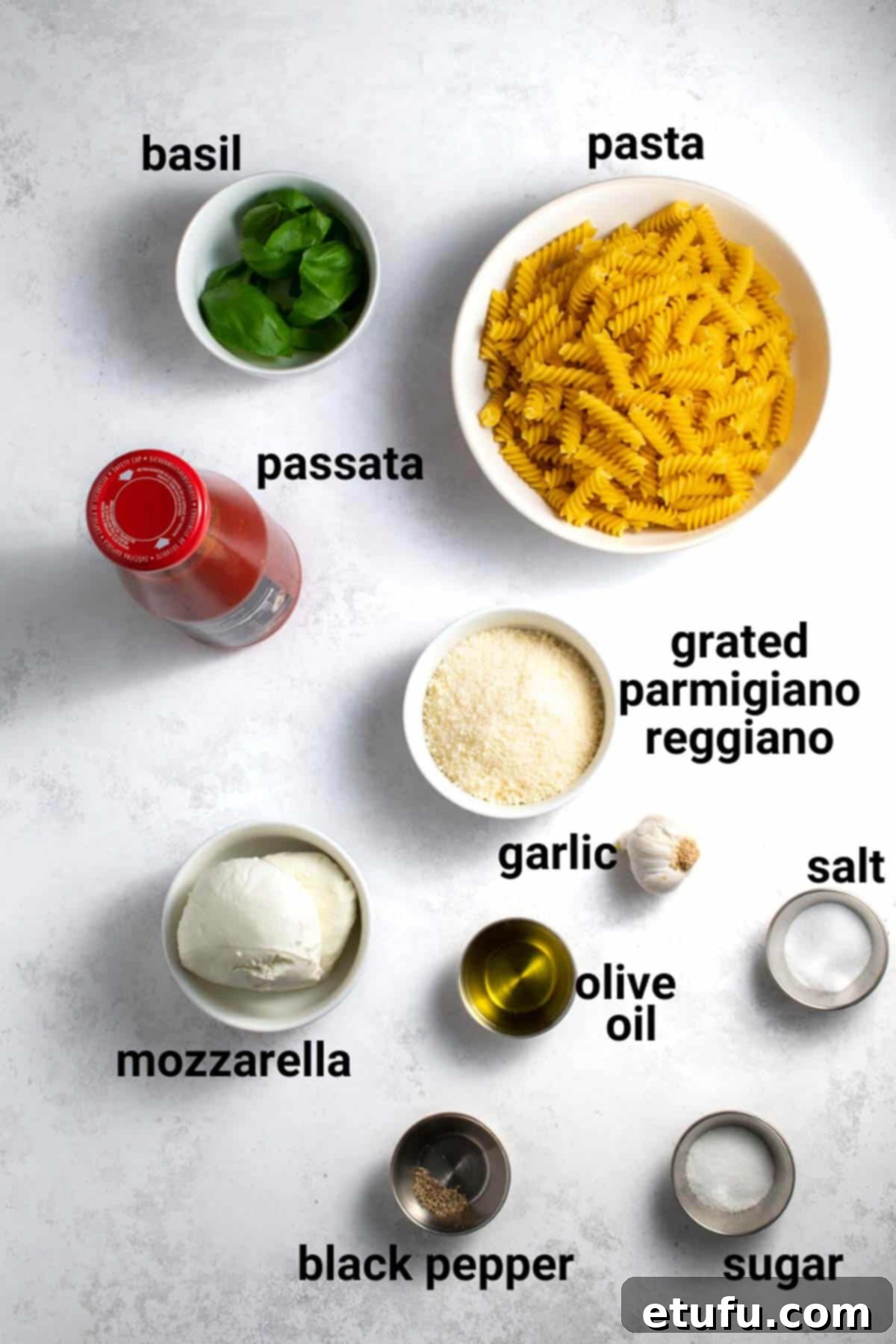
Crafting a truly memorable Pasta alla Sorrentina relies on understanding and appreciating each ingredient. Here’s a closer look at the key components and how you can make smart substitutions without compromising on taste:
Garlic
Garlic is fundamental to the aromatic base of any good Italian tomato sauce. For this recipe, you’ll need one whole garlic clove to infuse the sauce with its distinct flavor. We recommend lightly scoring the garlic clove before adding it to the hot oil. This technique helps to release its potent oils and a deeper, more mellow flavor profile as it cooks gently in the sauce, ensuring a robust aroma without overwhelming the other ingredients. Avoid burning the garlic, as it can impart a bitter taste.
Passata (Tomato Puree)
A high-quality passata is your secret weapon for a convenient yet deeply flavorful tomato sauce in this recipe. Also commonly known as ‘tomato puree,’ passata is strained, uncooked tomatoes that create a smooth, vibrant base. It’s crucial not to confuse it with tomato ‘paste,’ which is a concentrated product usually found in tubes or small tins and has a much thicker consistency and intense flavor.
Traditionally, authentic Sorrentina sauce would use fresh San Marzano tomatoes, revered for their balanced sweetness and low acidity, grown in the fertile volcanic soil of Italy’s Campania region. If San Marzano tomatoes aren’t available, excellent alternatives include Roma tomatoes (plum tomatoes), Jersey tomatoes, Campari tomatoes, or Cuore di Bue (Oxheart) tomatoes. The key is to select ripe, flavorful tomatoes that will contribute a rich, natural sweetness to your sauce.
Sugar
Adding a small amount of sugar to your tomato sauce might seem unconventional, but it plays a vital role in balancing the natural acidity of the tomatoes. This touch of sweetness rounds out the flavors, creating a more harmonious and delicious sauce. If you prefer a sugar-free diet, you can certainly omit it; the sauce will still be delicious, albeit with a slightly tangier profile.
Pasta
The choice of pasta is paramount for Pasta alla Sorrentina. You need a shape that can gracefully hold the rich tomato sauce and chunky mozzarella while maintaining its structural integrity during baking. Opt for pasta types with ridges, grooves, or hollows that act as perfect vehicles for the sauce. Here are a few excellent options:
- Fusilli pasta: Its spirals are excellent at catching sauce.
- Penne pasta: Tube-shaped with ridges, ideal for trapping bits of cheese and sauce.
- Paccheri pasta: Large, smooth tubes that provide a substantial bite.
- Rotini pasta: Similar to fusilli, its corkscrew shape ensures a good coating of sauce.
- Gemelli pasta: Twisted strands that intertwine with the sauce beautifully.
- Orecchiette pasta: Small, ear-shaped pasta that cups sauce and small ingredients.
- Farfalle pasta: The classic “bowtie” shape adds a fun texture and holds sauce well.
When cooking any of these pasta varieties, always adhere to the package instructions and aim for an “al dente” texture. This means the pasta should be cooked through but still firm to the bite, not mushy. Achieving al dente is crucial; it ensures the pasta holds its shape and texture during the baking process, preventing it from becoming soggy. Furthermore, investing in higher-quality pasta can significantly elevate your dish. Since pasta is truly the star of this show, choosing a premium brand often means better texture and flavor, allowing it to truly shine.
Mozzarella
For an authentic and delightfully gooey result, we recommend using fresh, whole mozzarella balls, preferably made from cow’s milk (fior di latte) or, for an extra luxurious touch, buffalo mozzarella. Cut the mozzarella into thick slices or tear irregular pieces by hand to create wonderful pockets of melted cheese throughout the dish. The fresh mozzarella will soften beautifully in the oven, imparting a creamy texture and mild flavor that perfectly complements the tomato sauce.
If you’re looking for an alternative with a slightly firmer texture and smokier flavor, Scamorza cheese can be an excellent substitute for mozzarella. It melts wonderfully and adds another layer of depth to the dish.
Parmigiano Reggiano
No authentic Italian pasta dish is complete without the king of cheeses, Parmigiano Reggiano. Its complex, nutty, and savory notes are indispensable for the true flavor profile of Pasta alla Sorrentina. While Parmigiano Reggiano is the traditional choice, a good quality Parmesan cheese or another hard, aged Italian cheese can serve as a more readily available and economical alternative, offering a similar salty, umami kick to your dish.
Fresh Basil
Fresh basil is more than just a garnish; it’s a crucial flavor component that brightens and lifts the entire dish. Its sweet, peppery aroma is characteristic of Sorrentina cuisine. Always use fresh basil leaves, torn or roughly chopped, for the best results, adding some to the sauce and more as a garnish after baking.
Olive Oil
As the cornerstone of Mediterranean cooking, good quality extra virgin olive oil is essential. It forms the base of the tomato sauce, gently frying the garlic and providing a silky richness that binds the flavors together. Choose a robust, fruity olive oil to enhance the overall taste of your Pasta alla Sorrentina.
Mastering Pasta alla Sorrentina: A Step-by-Step Guide
Creating this beloved Italian classic is a rewarding experience. Follow these detailed steps to achieve a perfectly balanced and utterly delicious Pasta alla Sorrentina:
To make the sauce: The Heart of the Dish
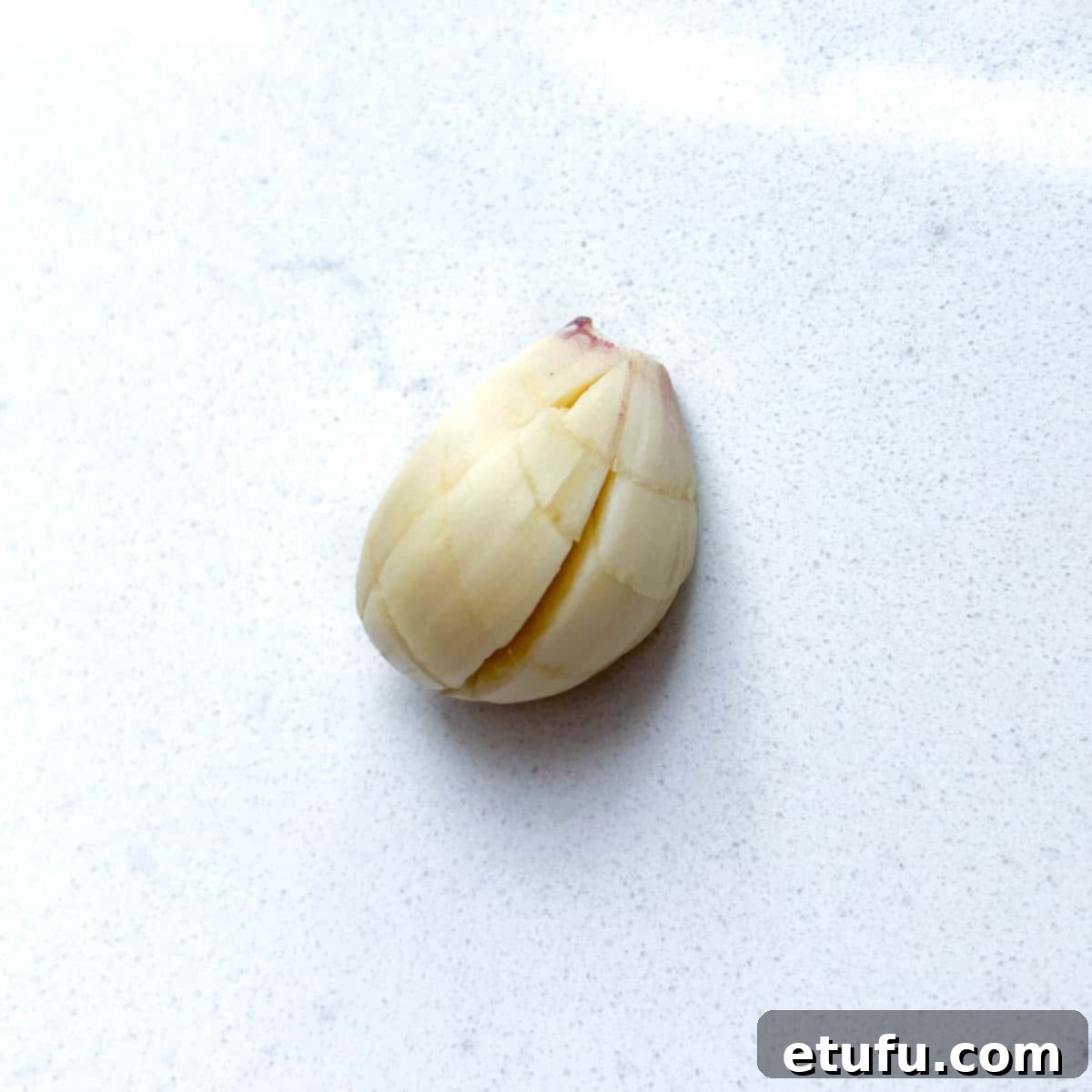
- Prepare the Garlic: Carefully peel one fresh garlic clove. Using a sharp knife, lightly score the surface of the clove; do not cut it all the way through. Keeping it whole allows the garlic to infuse its flavor gently into the oil and sauce without burning or becoming too assertive.

- Sauté the Garlic: In a large frying pan or saucepan, heat the olive oil over a medium heat. Add the scored garlic clove and fry gently for 1-2 minutes. The goal is a light golden color and a fragrant aroma, not a burnt crisp. Burnt garlic will impart an undesirable bitter flavor to your sauce, so monitor it closely.

- Build the Sauce Base: Carefully pour in the passata (tomato puree). Immediately add the salt, sugar (if using), freshly ground black pepper, and fresh basil leaves. Stir all ingredients thoroughly to combine them into a fragrant, vibrant sauce.

- Simmer the Sauce: Bring the sauce to a gentle simmer. Once simmering, cover the pan with a lid, reduce the heat to low, and let it cook for 25-30 minutes. Stir the sauce every few minutes with a wooden spoon to prevent it from sticking to the bottom or reducing too quickly. If it appears too thick, add a small splash of water to reach your desired consistency.
Safety Tip: When adding passata to hot oil, it can sometimes splatter vigorously. Keep the lid of the pan close at hand to shield yourself from any potential splashes.
Preparing the Pasta: Al Dente Perfection

- Cook the Pasta: Bring a large saucepan of heavily salted water to a rapid boil. Add your chosen pasta (e.g., penne, fusilli). Follow the cooking instructions on the pasta packet precisely, ensuring you cook it until it’s just “al dente.”
“Al dente” is an Italian term meaning “to the tooth.” It describes pasta that is cooked to be firm when bitten, yet still tender, without being raw or hard in the center. This texture is vital for a good pasta dish, especially one that will be baked.
- Drain the Pasta: Once al dente, thoroughly drain the pasta in a colander. Return the drained pasta to the saucepan. If your garlic clove in the sauce is still whole, you may remove it before combining.
Assembling the Dish: Layers of Flavor and Cheese
- Preheat Oven: Preheat your oven to 200℃ (390℉ or Gas Mark 6). This ensures the oven is ready for quick melting and bubbling of the cheese.
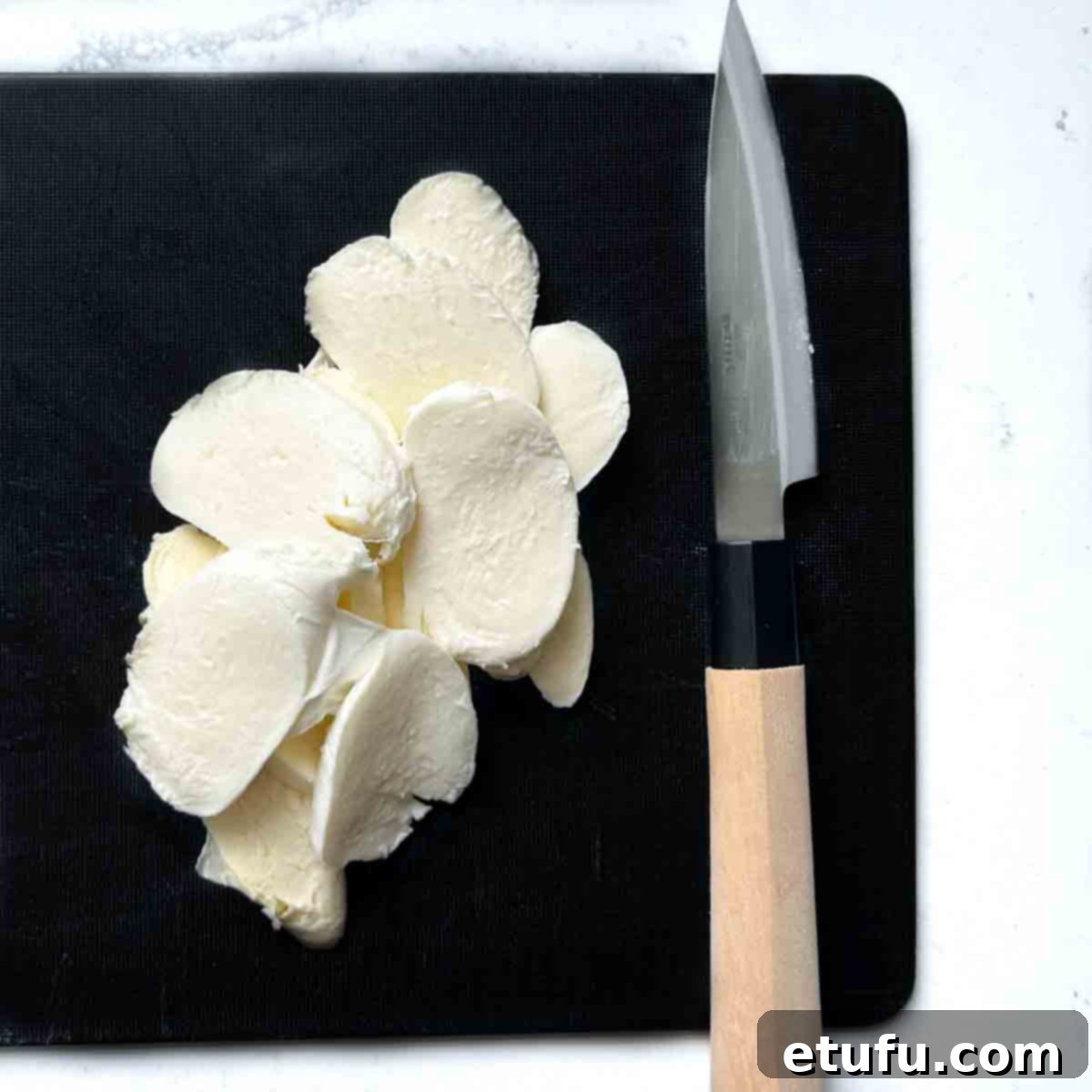
- Prepare the Cheeses: Slice the fresh mozzarella into manageable pieces, suitable for layering. Grate the Parmigiano Reggiano cheese finely, ready for sprinkling.
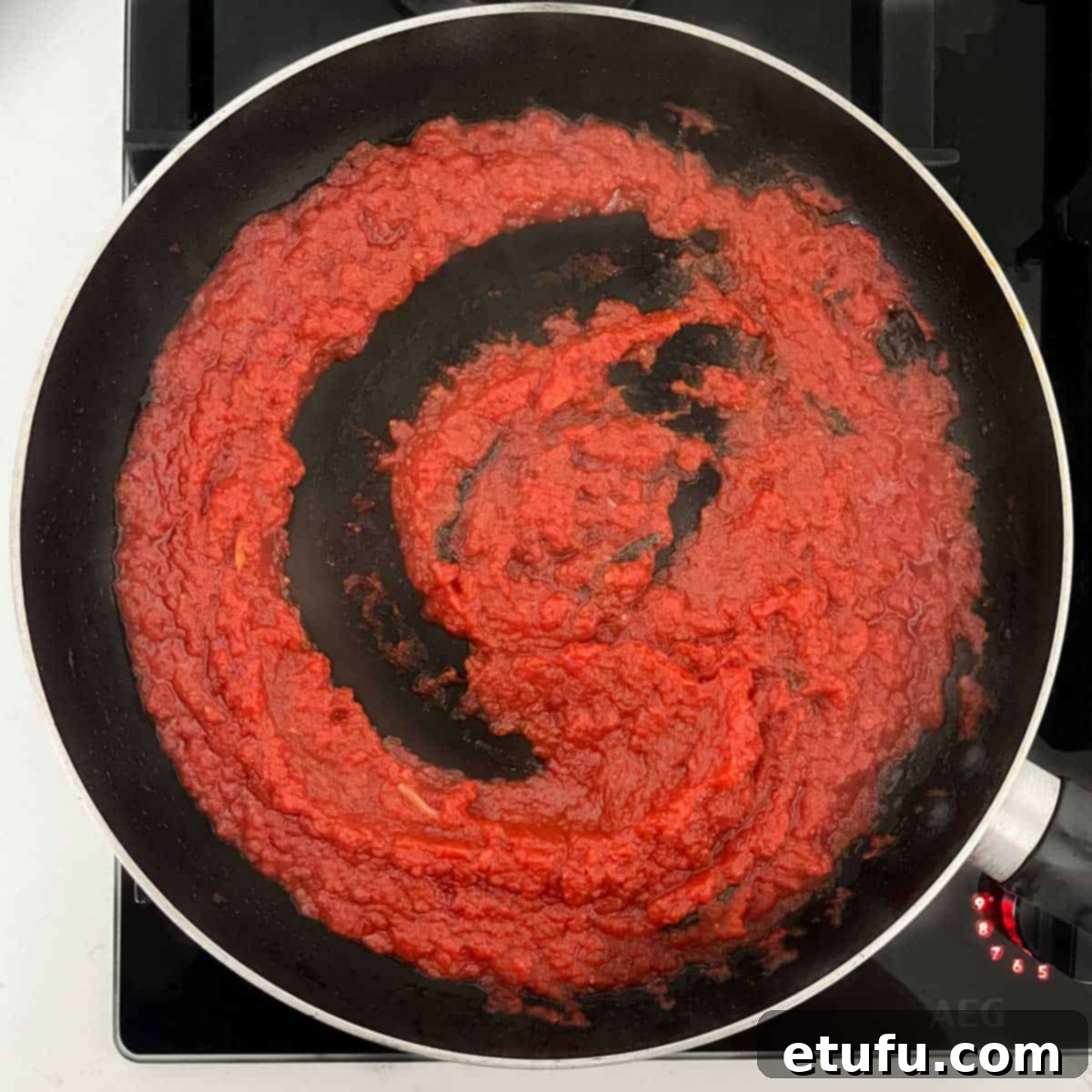
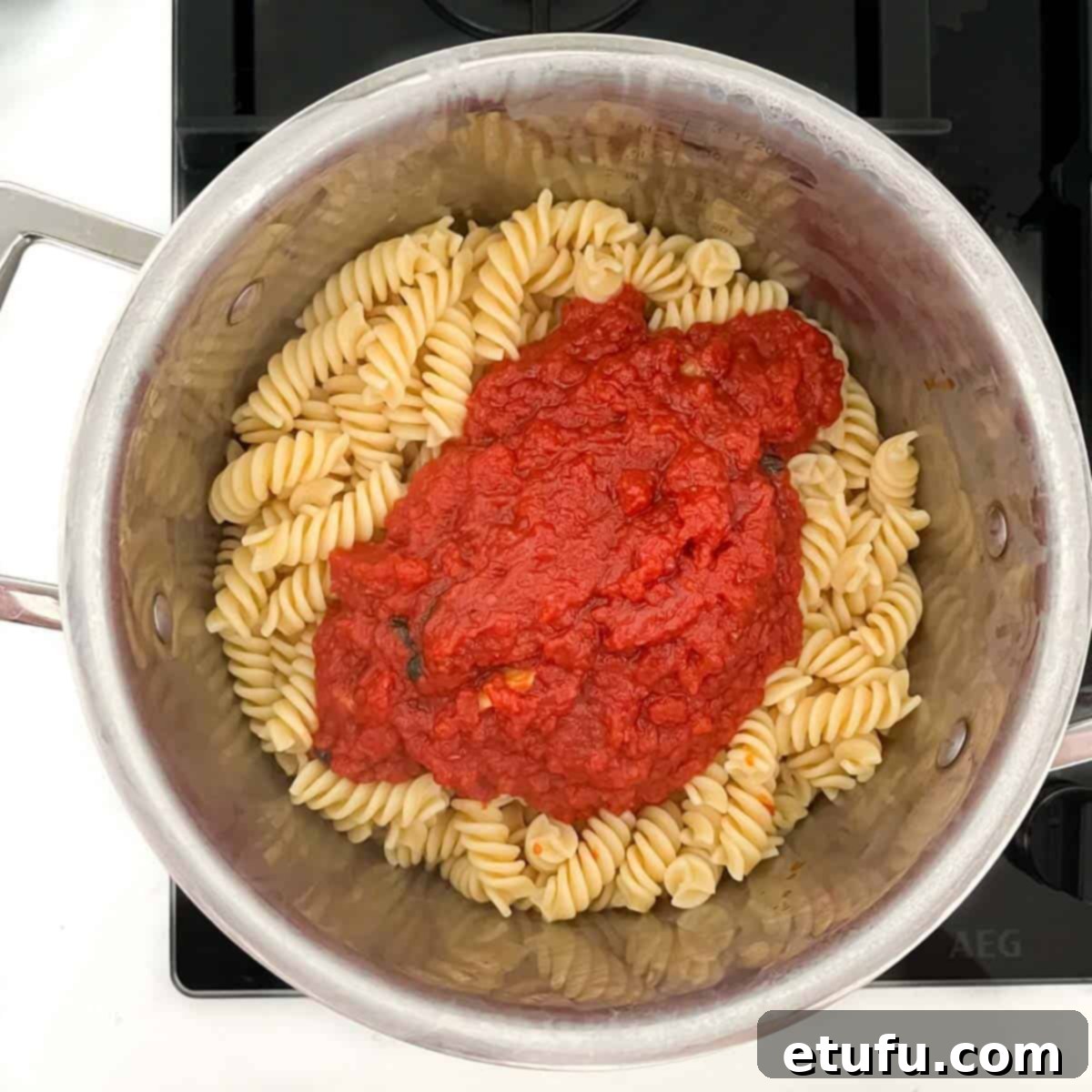
- Combine Pasta and Sauce: Once the Sorrentina sauce is perfectly cooked and slightly thickened, pour it directly over the drained, cooked pasta. Stir gently to ensure every piece of pasta is beautifully coated in the rich, fragrant tomato sauce.

- First Layer of Pasta: In your chosen baking dish (a cast iron skillet or an oven-safe casserole dish works wonderfully), spread half of the pasta and sauce mixture evenly to form the bottom layer.
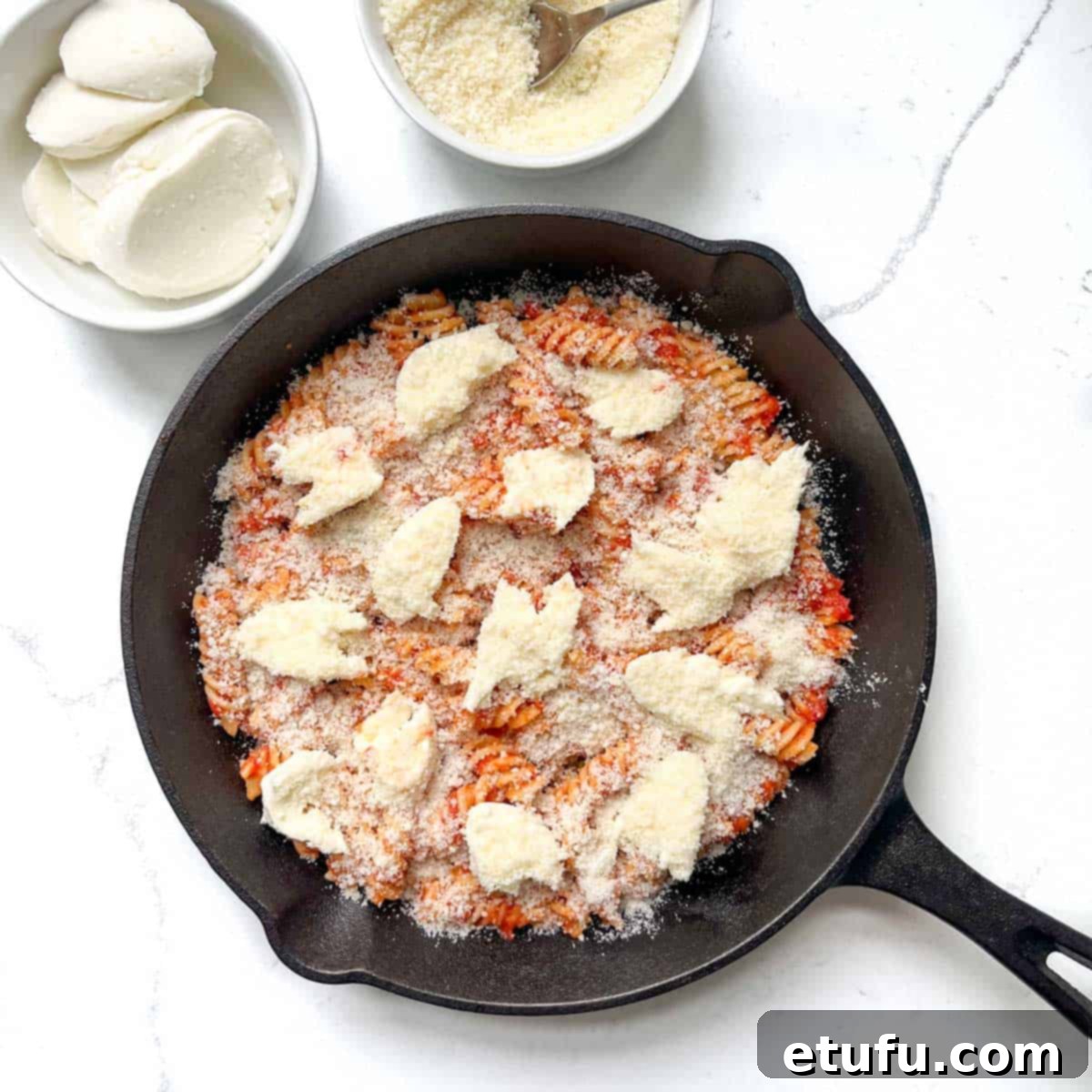
- First Layer of Cheese: Generously distribute half of the sliced mozzarella over the pasta. Follow this by sprinkling half of the grated Parmigiano Reggiano evenly over the mozzarella.
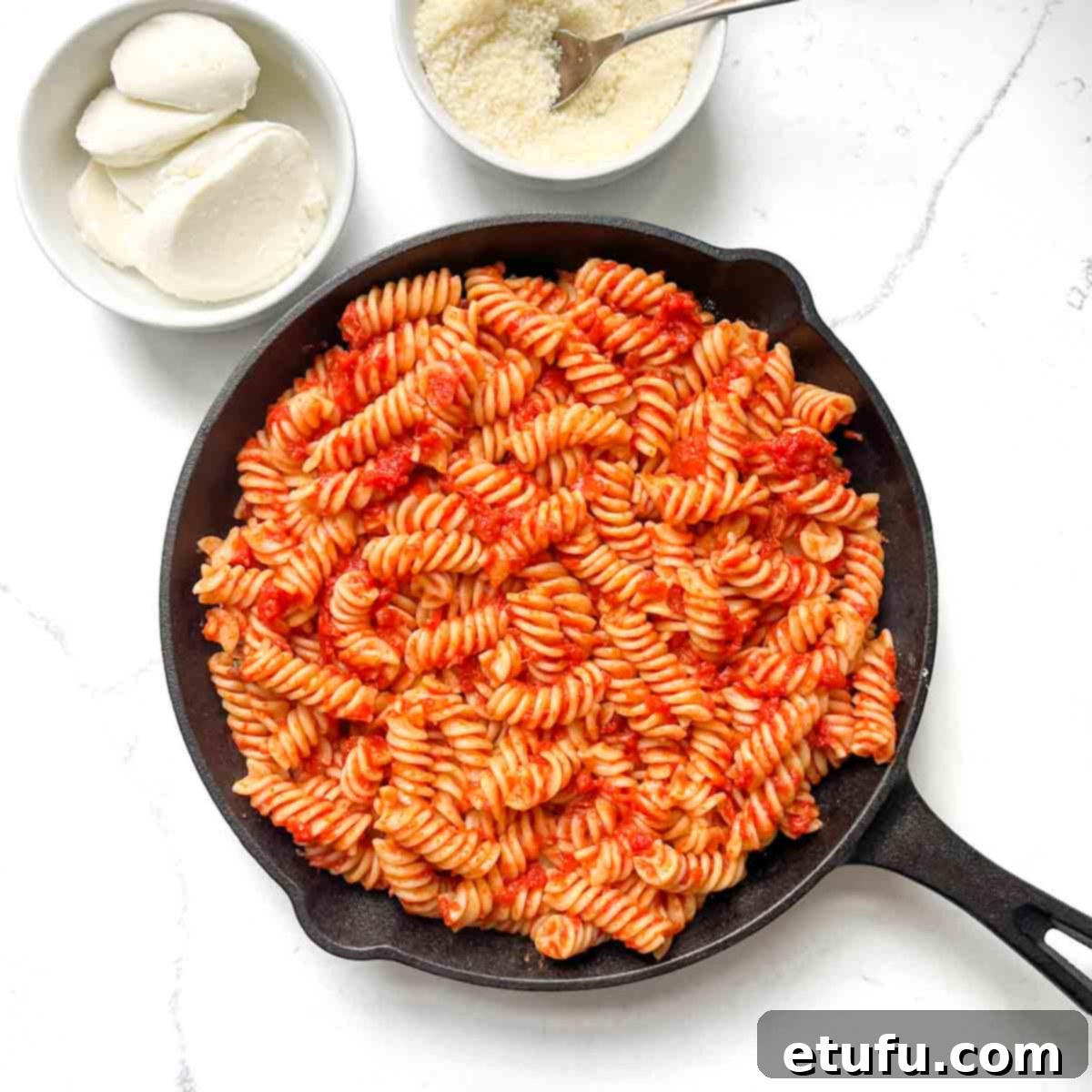
- Second Layer of Pasta: Carefully add the remaining pasta and sauce mixture on top of the first layer of cheese, spreading it out to create an even second layer.
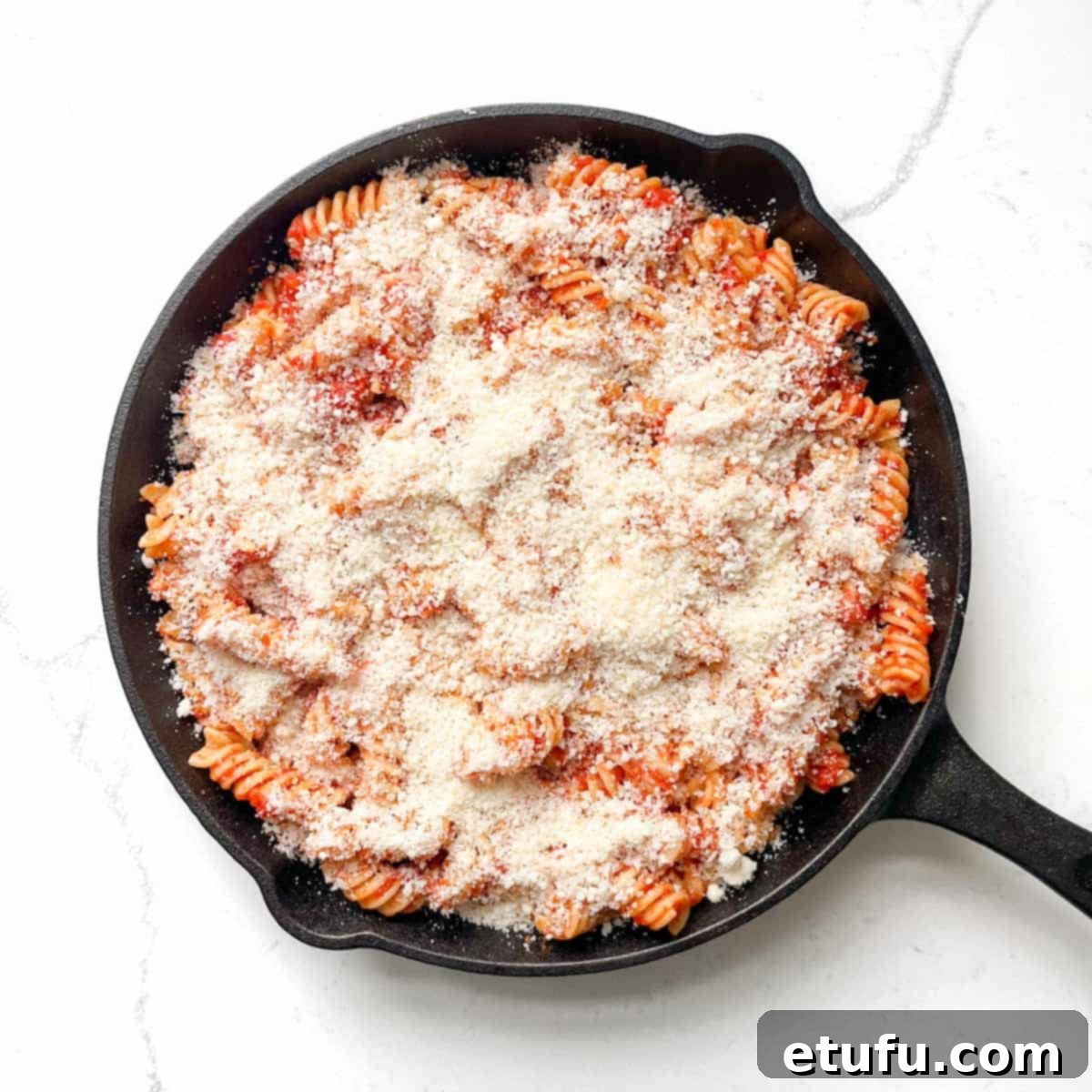
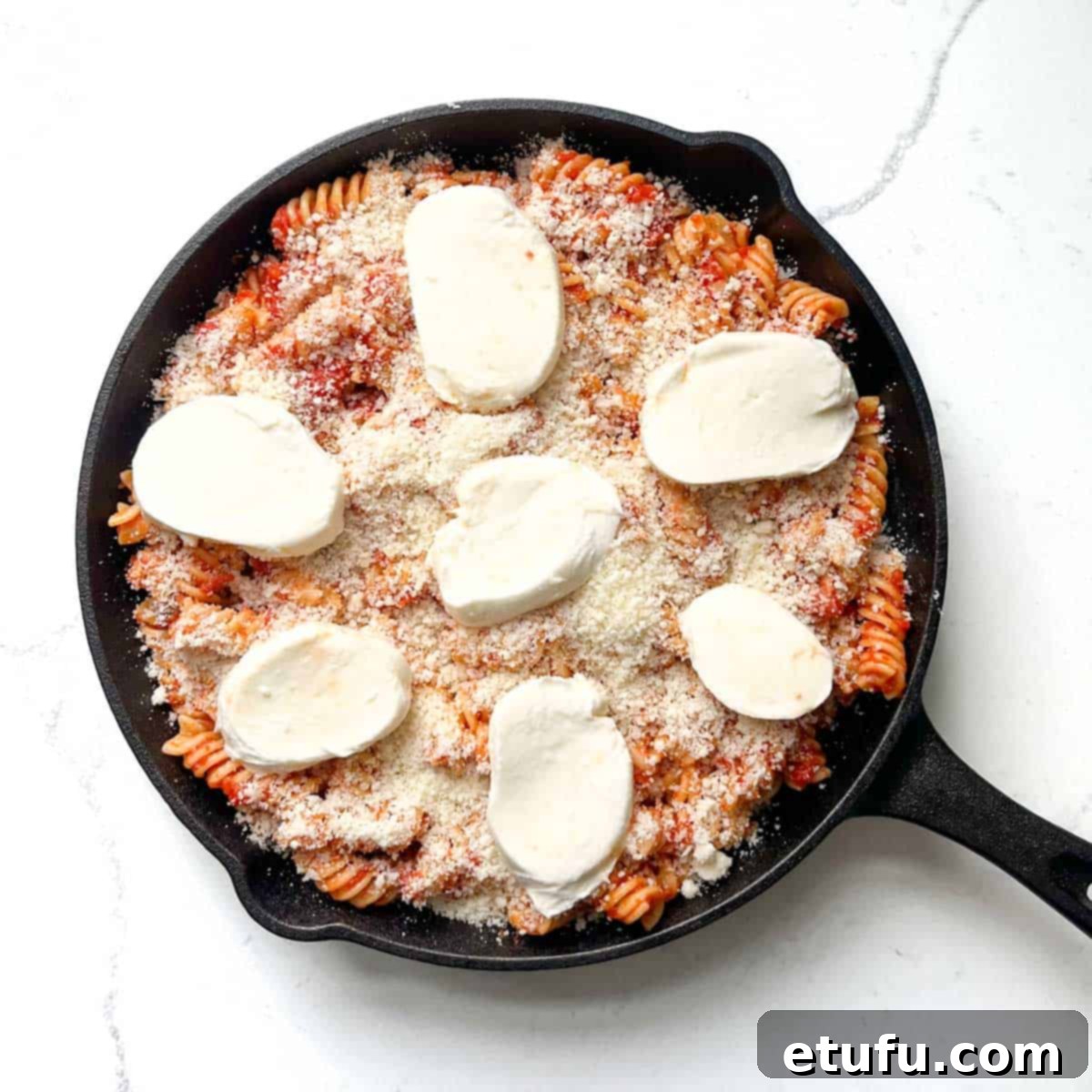
- Final Cheese Layer: Sprinkle the remaining Parmigiano Reggiano over the top, followed by an even distribution of the remaining mozzarella slices. This top layer of cheese will melt into a golden, bubbly crust.
- Bake to Perfection: Transfer the baking dish to the preheated oven and bake for approximately 10 minutes. The baking time is short, just enough for the cheeses to fully melt, become gloriously gooey, and slightly golden.
- Serve: Once out of the oven, scatter generously with more fresh basil leaves. For an extra touch of flavor, you can drizzle with a little extra virgin olive oil and add a few grinds of fresh black pepper. Serve hot and enjoy immediately!
Storing Your Leftover Pasta alla Sorrentina
Should you be fortunate enough to have any leftover Pasta alla Sorrentina, proper storage ensures you can enjoy its deliciousness later. Simply transfer any cooled leftovers to an airtight container and store it in the refrigerator. It will keep beautifully for up to 3-4 days. To reheat, you can use a microwave for a quick warm-up or gently heat it on the stovetop in a pan with a splash of water or broth, stirring occasionally until thoroughly warmed through. This helps to prevent the pasta from drying out and maintains its delightful texture.
Freezing for Future Feasts
Pasta alla Sorrentina is an excellent candidate for meal prep and freezing, allowing you to enjoy a homemade Italian meal on demand. For optimal results, it’s best to freeze the dish *before* it has been baked with the cheese. To do this, simply assemble the cooked pasta and sauce in an oven-safe dish as described in the assembly steps (but without the final cheese topping). Cover the dish tightly with a layer of plastic wrap, followed by a layer of aluminum foil, ensuring it’s completely sealed to prevent freezer burn. It can be frozen for up to 2-3 months.
When you’re ready to enjoy it, remove the dish from the freezer. Peel off the plastic wrap and foil. Now, add the mozzarella and Parmigiano Reggiano cheese toppings. Bake directly from frozen (you may need to add an additional 10-15 minutes to the baking time) or allow it to thaw in the refrigerator overnight before baking. Bake until it’s heated through, the cheese is melted and bubbly, and golden-brown. We do not recommend freezing the pasta once it has already been baked with the cheese, as the reheating process can often lead to a soggy texture and less desirable consistency for the cheese.
Creative Variations for Your Pasta alla Sorrentina
While the classic Pasta alla Sorrentina recipe with penne pasta, tomato sauce, mozzarella, Parmigiano Reggiano, and fresh basil is perfect as is, its versatility allows for exciting variations. Don’t hesitate to experiment with these ideas to tailor the dish to your preferences or whatever ingredients you have on hand:
- Add Italian Sausage or Pancetta: For those who crave a richer, heartier meal, incorporate cooked Italian sausage or crispy pancetta into the sauce. Simply brown the meat in a pan before adding it to the tomato sauce base; its savory notes will add incredible depth.
- Experiment with Different Pasta Types: While penne is a traditional choice, the beauty of this dish lies in its adaptability. Explore other pasta shapes like rigatoni, which has larger tubes to capture more sauce, or fusilli, whose spirals intertwine perfectly with the chunky ingredients. Each shape offers a unique textural experience.
- Embrace Gnocchi: For a delightful change, replace the pasta entirely with potato gnocchi. The soft, pillowy texture of gnocchi pairs exquisitely with the robust tomato sauce and melted cheese, creating an even more indulgent and comforting dish.
- Boost with Vegetables: Enhance the nutritional value and texture by adding sautéed vegetables to your sauce. Zucchini (courgette), eggplant (aubergine), or colorful bell peppers are excellent choices that complement the tomato base beautifully, adding freshness and extra vitamins.
- Explore Other Cheeses: Beyond mozzarella and Parmigiano Reggiano, consider experimenting with other Italian cheeses. A dollop of creamy ricotta cheese layered between the pasta can add a delightful richness, or a sprinkle of sharp Pecorino Romano can offer a bolder, saltier counterpoint to the sweetness of the tomatoes.
- Spice it Up: For those who appreciate a kick, infuse the sauce with additional spices. A pinch of red pepper flakes will add a subtle heat, while dried oregano can deepen the Mediterranean flavor profile. You can also intensify the garlic flavor by adding an extra clove or two to the initial sauté.
- Introduce Seafood: Given its coastal origins, a seafood variation makes perfect sense. Sauté some shrimp, calamari, or mussels and gently fold them into the finished sauce before layering for a gourmet touch.
- Fresh Herbs Beyond Basil: While basil is king, a hint of fresh oregano or a sprig of marjoram can also complement the tomato sauce beautifully, adding subtle new layers of aroma.
Perfect Pairings: What to Serve with Pasta alla Sorrentina
Pasta alla Sorrentina is a wonderfully hearty and satisfying meal on its own, but it can be beautifully complemented by a few simple accompaniments to create a complete and balanced Italian dining experience. Here are some serving suggestions to elevate your meal:
- Fresh Salad: A light, crisp salad provides a refreshing contrast to the richness of the pasta. Consider a classic Italian Panzanella Toscana salad with its vibrant tomatoes, cucumbers, and bread, or a simple green salad dressed with a vinaigrette.
- Crusty Bread: A staple in Italian meals, crusty bread is perfect for soaking up every last drop of the delicious tomato sauce. A warm baguette or a rustic Italian loaf would be ideal.
- Grilled Protein: For those looking to add more protein, serve Pasta alla Sorrentina alongside simply grilled chicken, flaky white fish, or succulent seafood. The delicate flavors of grilled proteins won’t overpower the pasta.
- Wine Pairing: Complement your meal with a glass of Italian wine. A medium-bodied red wine like a Chianti or a lighter Sangiovese pairs well with tomato-based dishes. Alternatively, a crisp white wine such as a Pinot Grigio or Vermentino offers a refreshing contrast.
- Garlic Bread: You can never have too much garlic! A warm, buttery garlic bread makes an excellent side, enhancing the overall savory profile of the meal.
- Roasted Vegetables: Enhance your meal with a side of roasted vegetables. Simple roasted zucchini, bell peppers, or even stuffed courgettes can add a lovely texture and additional nutrients.
- Olives and Antipasti: Start your meal with a small platter of Italian olives, cured meats, or other simple antipasti to set the authentic Italian tone.
Unlocking the Secrets to Perfect Pasta Every Time
Cooking pasta might seem straightforward, but mastering a few key techniques can elevate your dish from good to truly exceptional. Follow these essential tips to ensure your pasta is always perfectly cooked, just like in Italy:
- Use a Generous Amount of Salted Water: This is perhaps the most crucial rule for perfect pasta. Always use a very large pot filled with plenty of water, and generously salt it until it tastes like the sea. A large volume of water allows the pasta to cook evenly and prevents it from sticking together, while the salt penetrates the pasta itself, seasoning it from within. A good rule of thumb is to simply use your biggest pot available!
- Ensure a Rapid Boil: Before you even think about adding the pasta, make absolutely sure the water is at a rolling, rapid boil. Adding pasta to lukewarm or gently simmering water will result in sticky, mushy, and unevenly cooked pasta. The intense heat immediately sets the pasta’s starches, preventing it from clumping.
- Stir Immediately After Adding Pasta: As soon as you add the pasta to the boiling water, give it a good stir. This is another vital step to prevent the strands or shapes from sticking to each other or to the bottom of the pot, ensuring each piece cooks independently and perfectly.
- Cook to Al Dente: Always refer to the cooking instructions on your pasta packet, but remember that these are often just guidelines. The ultimate goal is “al dente” – cooked through but still firm to the bite. Taste your pasta a minute or two before the suggested cooking time; it should have a slight resistance. This texture is ideal for holding sauces and for dishes like Pasta alla Sorrentina, which undergo a secondary baking process.
- Drain, but Don’t Rinse: Once your pasta reaches the desired al dente stage, drain it thoroughly in a colander. Crucially, do not rinse the pasta. Rinsing removes the thin layer of starch that helps the sauce cling to the pasta, and it also cools the pasta down too quickly.
- Reserve Pasta Water: Before draining all the water, make a habit of saving about a cup of the starchy pasta cooking water. This liquid is a chef’s secret weapon; it can be added to your sauce later if it’s too thick, helping to loosen it up and creating a silky texture that binds the sauce to the pasta beautifully.
Explore More Delicious Pasta Recipes
If you’ve enjoyed the delightful flavors of Pasta alla Sorrentina, we invite you to explore more of our easy and irresistible pasta creations. From creamy indulgences to vibrant salads, there’s a pasta dish for every craving and occasion. Discover your next favorite recipe here:
Marry Me Chicken Pasta
Creamy Chicken and Chorizo Pasta
Creamy Steak Pasta
Curry Noodle Salad
Tuna Pesto Pasta
Spaghetti Arrabiata
Lemon Chicken Orzo Pasta
Creamy Italian Pasta Salad
Gigi Hadid Pasta Recipe
Recipe Card: Authentic Pasta alla Sorrentina

Italian Pasta alla Sorrentina – Oven-Baked
Print Recipe
Save
Ingredients
For the sauce
- 2 tablespoons olive oil
- 1 clove garlic (whole, lightly scored)
- 600 grams passata (tomato puree)
- ½ teaspoon salt
- 2 teaspoons sugar (optional, to balance acidity)
- few good grinds black pepper
- 10 fresh basil leaves
For the pasta
- 350 grams dry pasta – like fusilli, penne, or rigatoni
- salt to taste – we add 2 teaspoons salt to our pasta water for generous seasoning
For the toppings
- 200 grams fresh mozzarella (sliced or torn)
- 70 grams Parmigiano Reggiano – or good quality Parmesan cheese, freshly grated
- few extra fresh basil leaves for scattering
Instructions
To make the sauce
- Peel the garlic clove and lightly score its surface with a sharp knife, keeping it whole.
- In a large frying pan, heat the olive oil. Add the scored garlic clove and fry for 1-2 minutes over a medium heat until light golden. Avoid burning to prevent bitterness.
- Add the passata, salt, sugar (if using), pepper, and fresh basil leaves. Stir well to combine and bring to a gentle simmer.
- Cover the pan, reduce heat to low, and cook for 25-30 minutes, stirring every few minutes. Add a splash of water if it becomes too thick. Tip: Be careful as passata can splatter when added to hot oil; keep a lid ready to shield yourself.
To make the pasta
- Add pasta to a large saucepan of rapidly boiling, salted water. Cook according to package instructions until just al dente (firm to the bite).
- Drain the pasta in a colander and return it to the saucepan.
Assembling the dish
- Preheat the oven to 200℃/390℉/gas mark 6.
- Slice the mozzarella into smaller pieces and grate the Parmigiano Reggiano.
- Once the sauce is cooked and slightly thickened, pour it over the cooked pasta. Remove the whole garlic clove if it hasn’t disintegrated. Stir to combine thoroughly.
- In a baking dish, add half of the pasta and sauce mixture to form the bottom layer.
- Layer half of the sliced mozzarella on top of the pasta, followed by sprinkling half of the Parmigiano Reggiano.
- Add the remaining pasta and sauce mixture on top of the cheese layer.
- Top with the remaining Parmigiano Reggiano, then evenly distribute the remaining mozzarella over the top.
- Bake for 10 minutes, or until the cheese has melted and is bubbly and golden.
- Garnish with fresh basil leaves and serve hot. Drizzle with extra virgin olive oil and freshly ground black pepper, if desired.
**Nutritional data disclaimer**
Please keep in mind that the nutritional information provided below is calculated by a third party and we cannot guarantee its accuracy. We strive to offer the most precise information possible, but we do not take responsibility for any potential errors. Additionally, the nutritional value of this recipe may vary depending on the specific brands and products used. We highly recommend consulting with a qualified healthcare professional or a registered dietitian for personalized advice regarding your dietary needs.
Nutrition
For food safety advice, including guidance on food allergies
